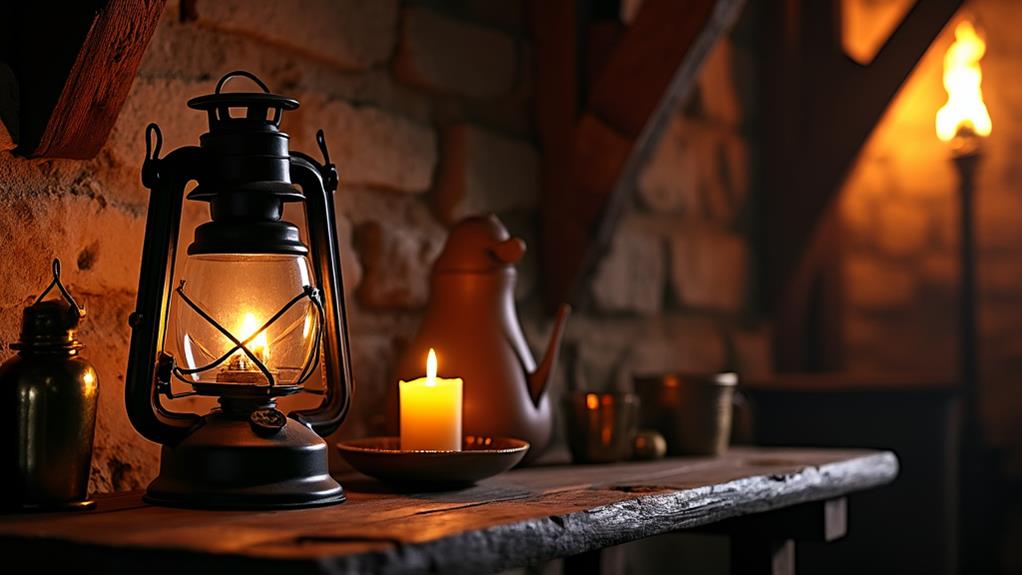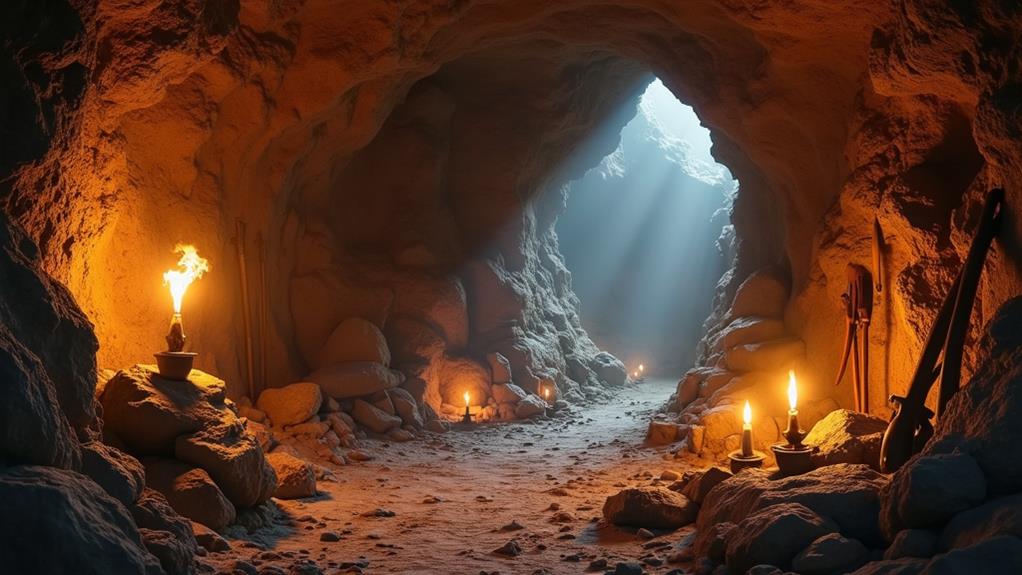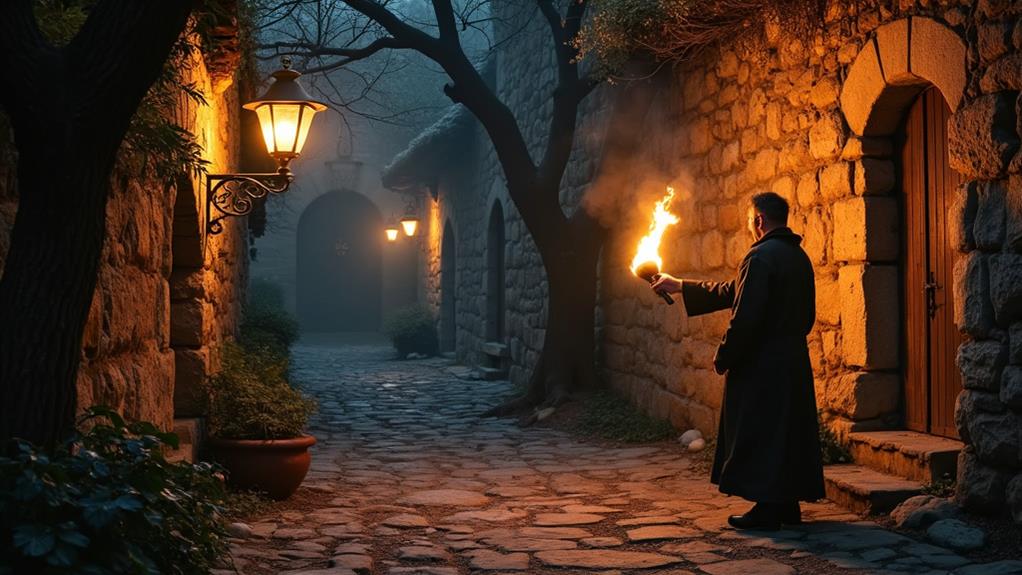What Did People Use Before Flashlights?

Imagine navigating a dark night without the convenience of a flashlight. Our ancestors relied on various light sources perfected over centuries, including candles, oil lamps, torches, and lanterns, each with its unique advantages and drawbacks. Candles were common but varied in quality and burn time. Oil lamps provided a steadier light but required constant maintenance. Torches, although effective, posed significant fire risks. These ancient solutions evolved over time, paving the way for modern lighting innovations. Curious about how these methods shaped contemporary lighting? There's more to uncover.
Early Light Sources

Throughout history, the quest for light has driven people to innovate various light sources. Before the invention of flashlights, our ancestors heavily relied on campfires. These fires provided not just warmth but also essential illumination, making them indispensable for survival.
As societies progressed, oil lamps became a common light source. Crafted from materials like clay, stone, or metal, these early lamps used wicks soaked in animal fats or oils. Unlike campfires, oil lamps offered a more portable and practical light option for indoor use and travel.
Candles emerged as another popular method. The aristocracy preferred beeswax candles for their pleasant aroma and cleaner burn. Early candles typically burned quickly, lasting about an hour. For the lower classes, tallow candles made from animal fat were a cheaper, albeit less pleasant, alternative.
These innovations in early light sources highlight humanity's drive to conquer darkness and create portable light solutions. From primitive campfires to sophisticated oil lamps and candles, each method marked a step forward in the quest for reliable light.
Candles and Oil Lamps
Before the invention of flashlights, people relied on candles and oil lamps for illumination. The aristocracy favored beeswax candles for their longer burn time and cleaner flame. In contrast, the lower classes used oil lamps made from clay, stone, or metal, which burned animal fats or oils. Although these lamps were less efficient and emitted unpleasant odors, they provided a portable and stable source of light.
Early Lighting Methods
Imagine life without the convenience of electric lamps. Before flashlights, people depended on candles and oil lamps for nighttime illumination. Ancient civilizations perfected the creation of portable lighting with ceramic lamps filled with oil. These lamps used wicks soaked in fuel, providing a steady flame essential for homes and public spaces.
Candles, made from beeswax or tallow, were another common light source. Early candles often burned out in less than an hour, yet they were crucial for reading, working, and moving around after sunset. Oil lamps, which burned animal fats or oils, were particularly important for the lower classes. These lamps represented a significant advancement from natural lighting sources, like campfires, to more reliable artificial methods.
In the 19th century, kerosene lamps revolutionized lighting. They offered a safer and more efficient alternative to earlier flame-based methods, providing brighter light and easier maintenance. This innovation paved the way for the electric lighting solutions we enjoy today. Through these developments, we can appreciate the progress made in the quest for artificial illumination.
Aristocracy's Beeswax Candles
In the 19th century, the aristocracy favored beeswax candles for their clean burn and pleasant aroma, which contrasted sharply with the smoky, unpleasant odor of tallow candles used by the lower classes. Beeswax candles were highly valued, symbolizing wealth and sophistication.
The production of beeswax candles was labor-intensive, involving careful extraction and purification of beeswax from beehives, making them more expensive. Tallow, derived from animal fat, was cheaper but produced more soot and an unpleasant odor.
For those who couldn't afford beeswax candles, oil lamps served as an alternative. These lamps often burned fuels like fish oil or whale oil, which were messy and odorous. While oil lamps provided longer-lasting light compared to early candles, they were primarily used by the lower classes.
The transition from traditional lighting methods, including beeswax candles and oil lamps, to electric lights marked a significant technological advancement, forever changing how people illuminated their homes.
Oil Lamps Variations
Oil lamps, a staple of lighting before the advent of electric lights, burned animal fats or vegetable oils to provide steady and long-lasting illumination. Unlike candles, which often burned out within an hour, oil lamps offered a more practical solution for extended use. Various designs existed, including ceramic lamps from ancient Greece, which used wicks soaked in oil for efficient portable lighting.
Candles were another common flame-based lighting option, but their efficiency was limited. Early candles, often made from beeswax for the wealthy, burned quickly, making them less practical for prolonged use. In contrast, oil lamps could be fueled with readily available animal fats or vegetable oils, ensuring a more reliable and sustained light source. For the lower classes, tallow candles and lamps were the norm, though they were less pleasant due to the odor and smoke.
The transition from these flame-based lighting methods to electric lights in the late 19th century transformed human illumination. However, the practicality and efficiency of oil lamps, especially those with ceramic designs and wicks, made them an essential part of life before flashlights became widespread.
Torches and Lanterns

Before the advent of flashlights, torches made from wood and cloth soaked in flammable substances were a common source of portable light. Lanterns, typically fueled by oil or kerosene, offered longer-lasting illumination and featured protective casings to reduce the risk of fire. These early lighting tools were essential for homes, farms, and outdoor activities, providing both illumination and a measure of safety.
Early Torch Materials
Before the invention of flashlights, people relied on torches, lanterns, and candles for illumination, utilizing materials that were readily available. Torches were typically made from wood or bamboo, with one end wrapped in cloth or fiber soaked in flammable substances like animal fat or oil. These torches provided portable lighting through open flames but posed significant safety risks due to their potential to cause fires.
Lanterns offered a safer alternative. Early lanterns featured enclosures made of glass or metal to shield the flame from wind and precipitation, making them more reliable in diverse weather conditions. They burned oils or kerosene as fuel sources, providing a controlled, portable light. Ancient civilizations, such as the Greeks, crafted ceramic lamps filled with oil and used wicks to produce light for various activities.
Candles, especially those made from beeswax, became a popular lighting solution until the 19th century. They offered a more stable but still temporary source of light compared to modern technology. Despite their limitations, these early methods of illumination were essential for daily life before the advent of electric flashlights.
Lantern Oil Sources
Moving from the materials used in early torches, let's investigate the different sources of fuel that powered lanterns and torches. Before the advent of flashlights, people relied heavily on various types of oil and fat for illumination. Here are the main sources of oil used:
- Animal Fats: Many ancient civilizations utilized animal fats as a primary oil source. These fats were rendered from animals and used in oil lamps to produce a steady light.
- Vegetable Oils: Olive oil was particularly popular in Mediterranean regions. It provided a cleaner burn compared to animal fats and was widely available.
- Kerosene: Emerging in the 19th century, kerosene quickly became a favored fuel. It provided a brighter and more efficient light source, transforming lantern use.
Lanterns, often made from ceramic or metal, utilized these oils with wicks to produce light. Torches, on the other hand, were frequently soaked in flammable materials like animal fats or resin to ensure consistent burning. These traditional light sources, though effective, came with risks. Open flames from torches and lanterns could easily ignite nearby materials, posing significant safety hazards. Despite these dangers, the use of oil-based illumination methods paved the way for developing modern portable lighting solutions, like flashlights.
Light and Safety
Before the advent of modern flashlights, torches and lanterns were essential lighting solutions but came with significant safety concerns. Torches, typically made from wood and dipped in animal fat or oil, provided light but posed fire hazards. Lanterns, constructed from glass or metal and filled with oil or kerosene, produced steady illumination via a wick but handling flammable liquids was risky.
Candles, particularly beeswax ones favored by the aristocracy, were portable but had a short burn time, offering only about an hour of light. Oil lamps, commonly used by the lower classes, burned unpleasant fuels and were inefficient. The transition to portable electric lighting marked a significant advancement, enhancing both safety and convenience.
Comparison of traditional light sources:
| Light Source | Advantages | Disadvantages |
|---|---|---|
| Torches | Bright light, easy to make | Fire hazard, short-lasting |
| Lanterns | Steady illumination | Risk of spills, fire hazard |
| Candles | Portable, easy to use | Short burn time, limited light |
| Oil Lamps | Affordable, common | Unpleasant fuels, inefficient |
Switching to portable electric flashlights was revolutionary, providing safer and more reliable illumination without the risks associated with open flames.
Ancient Lighting Methods
Ancient civilizations ingeniously harnessed diverse lighting methods to illuminate their surroundings, essential for activities during the night. Among the earliest methods were campfires, which provided not only illumination but also warmth and protection, playing a fundamental role in daily life.
As societies evolved, so did their lighting techniques. Oil lamps emerged as a significant advancement, crafted from materials like clay, stone, or metal and filled with animal fats or oils. The Greeks, for instance, developed ceramic oil lamps that offered portable lighting solutions for homes and public spaces, enabling people to carry light wherever they went.
Candles, primarily made from beeswax, were another significant development. Early candles had a short lifespan, burning for about an hour, yet they marked a noteworthy step towards more controlled and portable lighting.
Key ancient lighting methods include:
- Campfires - Essential for survival, providing light, heat, and safety.
- Oil Lamps - Portable and efficient, using animal fats or oils.
- Candles - Made from beeswax, offering controlled illumination.
Ancient civilizations' quest to conquer darkness laid the groundwork for future lighting innovations.
Development of Electric Light

The development of electric light marked a revolutionary period in the history of illumination. Early efforts in electric lighting began with Sir Humphry Davy's electric arc lamp in 1802. Using two carbon rods and a high-voltage battery, Davy's innovation produced an intense light, though it wasn't practical for everyday use.
A major breakthrough came in 1879 when Thomas Edison developed the incandescent electric light bulb. Edison's invention transformed both indoor and outdoor lighting, offering a safer and more reliable alternative to flammable torches, candles, and oil lamps.
Economic electricity generation became feasible with the introduction of dynamo machines in the late 19th century, making electric lighting accessible for households and businesses. This marked the beginning of widespread household lighting, fundamentally changing how people lived and worked after dark.
In 1887, the invention of the dry cell battery provided a safe and stable power source for portable lighting. This innovation was crucial for the development of battery-powered electric lights, ultimately leading to the creation of the flashlight.
Transition to Modern Light
The transition from traditional fuel-based lighting to modern electric illumination began with Thomas Edison's invention of the incandescent light bulb in 1879. This innovation revolutionized both indoor and outdoor lighting, offering a safer and more reliable alternative to candles and oil lamps. The incandescent bulb's electric glow marked a significant departure from the natural and artificial light sources that had been used for centuries.
The next major leap in lighting technology came with the introduction of dry cell batteries in 1887. These portable and safer power sources enabled the creation of the first battery-powered flashlights in 1899. Early flashlights, which used carbon-filament bulbs and D-sized batteries, represented a significant advancement in personal illumination, despite their initial limitations of weight and short battery life.
Key advancements in this transition include:
- Incandescent Electric Light Bulb (1879): Revolutionized illumination, reducing fire hazards.
- Dry Cell Batteries (1887): Enabled portable electric power, enhancing safety and convenience.
- First Battery-Powered Flashlights (1899): Introduced practical, handheld illumination.
These innovations collectively marked the shift from traditional lighting methods to modern, efficient, and safe electric solutions, fundamentally changing how we experience light.




